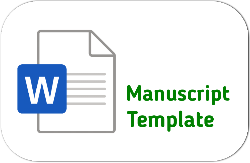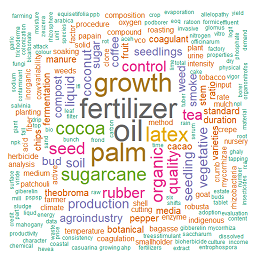Kajian Produksi Kopi Arabika (Coffea arabica) pada Berbagai Ketinggian Tempat di Kabupaten Temanggung
DOI:
https://doi.org/10.25181/jaip.v12i2.3497Keywords:
altitude, arabica coffee, coffee area, coffee production, productivityAbstract
Several factors, including the less-than-optimal altitude of Arabica coffee planting influence the low productivity of Arabica coffee in Temanggung Regency. The lack of rejuvenation of production plants means that old coffee plants have low productivity; apart from these two factors, farmers do not have good plant management skills. This research further examines the influence of altitude on Arabica coffee production. This research was carried out in Temanggung Regency, with the sub-districts that were the sample for this research being Ngadirejo District, with an altitude range of 900-1150 m asl, Parakan District, with an altitude range of 1150-1400 m asl, and Kledung District with an altitude range of more than 1400 m asl. The sampling method employed in this study is a purposive sampling technique; the researcher directly determines the location and source of research information. A total of 28 participants responded to this study, with an assessment sample taken of 5% of the population of Arabica coffee plantations that bear fruit. The analysis used the linear regression method of a fixed variable, namely height, and independent variables, namely production, productivity, and evaluation, with a significance level of 5%. The research results show that altitude does influence productivity. If altitude increases, productivity will also increase.Downloads
References
Anhar, A., Abubakar, Y., Widayat, H. P., Muslih, A. M., Romano, & Baihaqi, A. (2021). Altitude, shading, and management intensity effect on arabica coffee yields in Aceh, Indonesia. Open Agriculture, 6(1), 254–262. https://doi.org/10.1515/opag-2021-0220
Arvi, D., Syakur, & Karim, A. (2019). Hubungan ketinggian tempat dan kelerengan terhadap produksi kopi arabika gayo 1 di Kabupaten Gayo Lues. Jurnal Ilmiah Mahasiswa Pertanian, 4(4), 596–602. https://jim.usk.ac.id/JFP/article/download/12826/6313
Bakoh, B., & Wibawanti, R. (2023). Peningkatan Kapabilitas Penanganan OPT Tanaman Kopi. Ditjenbun.Pertanian.Go.Id. https://ditjenbun.pertanian.go.id/peningkatan-kapabilitas-penanganan-opt-tanaman-kopi/
Cahyadi, M. D. P. A., Tarjoko, & Purwanto. (2021). Pengaruh ketinggian tempat terhadap sifat fisiologi dan hasil kopi arabika (Coffea arabica) di dataran tinggi desa Sarwodadi Kecamatan Pejawaran Kabupaten Banjarnegara. Jurnal Ilmiah Media Agrosains, 7(1), 1–7. https://jurnal.polibara.ac.id/index.php/agrosains/article/view/215
Cassamo, C. T., Mangueze, A. V. J., Leitão, A. E., Pais, I. P., Moreira, R., Campa, C., Chiulele, R., Reis, F. O., Marques, I., Scotti-Campos, P., Lidon, F. C., Partelli, F. L., Ribeiro-Barros, A. I., & Ramalho, J. C. (2022). Shade and altitude implications on the physical and chemical attributes of green coffee beans from Gorongosa Mountain, Mozambique. Agronomy, 12(10). https://doi.org/10.3390/agronomy12102540
Dias, C. G., Martins, F. B., & Martins, M. A. (2024). Climate risks and vulnerabilities of the Arabica coffee in Brazil under current and future climates considering new CMIP6 models. Science of The Total Environment, 907(167753). https://doi.org/10.1016/j.scitotenv.2023.167753
Dirjenbun. (2023). Peningkatan Kapabilitas Penanganan OPT Tanaman Kopi. Ditjenbun.Pertanian.Go.Id. https://ditjenbun.pertanian.go.id/peningkatan-kapabilitas-penanganan-opt-tanaman-kopi/
Distanbun. (2021). Kopi Arabika Jawa Tengah. Distanbun JatengProv.
Erwiyono, R., Yacob, R. Y., & Usmadi. (2009). Pengaruh pola curah hujan terhadap produksi kopi: Studi di satu perkebunan di Banyuwangi. Jurnal Agrotropika, 14(1), 29–36. https://doi.org/10.23960/ja.v14i1.4227
Escamilla-Prado, E., Tinoco-Rueda, J., Pérez-Villatoro, H. A., de Jesús Aguilar-Calvo, Á., Sánchez-Hernández, R., & Ayala-Montejo, D. (2021). Socio-ecological Transformation in the coffee agroecosystem affected by rust in Chiapas, México. Revista Fitotecnia Mexicana, 44(4), 643–653. https://www.scienceopen.com/document?vid=b247ce78-7b1e-4fe1-9047-c4a97b90d733
Herman, M., & Tjahjana, B. E. (2012). Penyiapan lahan untuk budidaya tanaman kopi. In Bunga Rampai Inovasi Teknologi Tanaman Kopi untuk Perkebunan Rakyat (p. 57). Unit Penerbitan dan Publikasi Balittri.
Isyariansyah, M. D., Sumarjono, D., & Budiraharjo, K. (2018). Analisis faktor-faktor produksi yang mempengaruhi produksi kopi robusta di Kecamatan Sumowono Kabupaten Semarang. Agrisocionomics: Jurnal Sosial Ekonomi Pertanian, 2(1), 31. https://doi.org/10.14710/agrisocionomics.v2i1.1482
Kapuangan, W., & Thaha, A. R. (2023). Pengaruh topografi terhadap beberapa sifat kimia tanah pada perkebunan kopi arabika rakyat di Desa Sanik Kecamatan Malimbong-Balepe’ Kabupaten Tana Toraja. Agrotekbis: Jurnal Ilmu Pertanian, 11(5), 1289–1296. https://doi.org/10.22487/agrotekbis.v11i5.1891
Khayati, N., Wachjar, A., & Sudarsono, . (2020). Pengelolaan pemangkasan tanaman kopi arabika (Coffea arabica L.) di Kebun Kalisat Jampit, PT Perkebunan Nusantara XII (Persero), Bondowoso, Jawa Timur. Buletin Agrohorti, 7(3), 295–301. https://doi.org/10.29244/agrob.v7i3.30531
Lubis, M. A., & Marbun, P. (2023). Penilaian kesesuaian lahan kopi arabika di Kecamatan Pahae Julu dan Adian Koting. Jurnal Online Agroteknologi, 11(1), 19–25. https://talenta.usu.ac.id/joa/article/download/13165/6281
Marbun, P., Bintang, Tampubolon, K., Sihombing, F. N., Simanjuntak, D. R., Irly, I., & Sinuraya, M. (2023). Identification of soil physicochemical, land suitability, and its relationship to Coffee arabica yielding based on plant age groups. Coffee Science, 18(1). https://doi.org/10.25186/.v18i.2123
Maryuna, S., Hartuti, S., & Fadhil, R. (2022). Penilaian sensori kopi arabika gayo pada berbagai ketinggian menggunakan seduhan V60. Jurnal Ilmiah Mahasiswa Pertanian, 7(4), 787–790. https://doi.org/10.17969/jimfp.v7i4.22005
Mawardah, N., & Ariska, N. (2022). Teknik Pemeliharaan dan produksi kopi arabika (Coffea arabica) di Kabupaten Aceh Tengah. Jurnal Pertanian Agros, 24(3), 1243–1246. https://doi.org/10.37159/jpa.v24i3.2202
PPID, T. (2022). PPID Temanggung. PPID.
Rizaty, M. A. (2022). Konsumsi Kopi Indonesia Terbesar Kelima di Dunia pada 2021. DataIndonesia.Id.
Saeed, S., Younus, M., Barozai, K., Ahmad, A., & Shah, S. H. (2014). Impact of altitude on soil physical and chemical properties in Sra Ghurgai (Takatu mountain range) Quetta, Balochistan. International Journal of Scientific & Engineering Research, 5(3), 730–735.
Sari, S. P. P., Hasan, I., & Ilsan, M. (2023). Faktor yang mempengaruhi produksi kopi arabika di Kabupaten Toraja Utara (Studi kasus di Desa Paonganan, Kecamatan Buntu Pepasan). Wiratani: Jurnal Ilmiah Agribisnis, 6(1), 34. https://doi.org/10.33096/wiratani.v6i1.114
Sciences, D. of A. (2023). Productive Age for Ideal Coffee Plants. Program Studi Doktor Ilmu Pertanian Universitas Medan Area. https://doktor.pertanian.uma.ac.id/2023/04/usia-produktif-bagi-tanaman-kopi-yang-ideal/
Sihite, L., Marbun, P., & Supriadi. (2015). Hubungan ketinggian tempat dan kemiringan lereng tehadap produksi kopi arabika sigarar utang di Kecamatan Lintong Nihuta. Jurnal Online Agroekoteknologi, 3(2), 666–673. https://doi.org/10.32734/jaet.v3i2.10349
Silalahi, A. V., & Rosyadi, R. I. (2024). Evaluasi kesesuaian lahan kopi robusta (Coffea canephora) Desa Pucaksari Kecamatan Busungbiu Kabupaten Buleleng menggunakan analisis sistem informasi geografi. Jurnal Spatial Wahana Komunikasi Dan Informasi Geografi, 24(1), 21–30. https://doi.org/10.21009/spatial.241.003
Siregar, S. (2012). Statistik Parametrik untuk Penelitian Kuantitatif. Bumi Aksara.
Sobari, I., & Purwanto, E. H. (2012). Pengaruh jenis tanaman penaung terhadap pertumbuhan dan persentase tanaman berbuah pada kopi arabika varietas Kartika 1. Buletin Riset Tanaman Rempah Dan Aneka Tanaman Industri, 3(3), 217–222. http://ejurnal.litbang.pertanian.go.id/index.php/bultri/article/view/1085
Sugiyono. (2007). Statistika untuk penelitian. CV. Alfabeta.
Syakir, M., & Surmaini, E. (2017). Perubahan iklim dalam konteks sistem produksi dan pengembangan kopi di Indonesia. Jurnal Litbang Pertanian, 36(2), 77–90. https://doi.org/10.21082/jp3.v36n2.2017.p77-90
Wang, N., Jassogne, L., Asten Van, P. J. ., & Mukasa, D. (2015). Evaluating coffee yield gaps and important biotic, abiotic, and management factors limiting coffee production in Uganda. 63, 1–11.
Yao, R., Chen, Y., Lü, X., Wang, J., Yang, F., & Wang, X. (2023). Altitude-related environmental factors shape the phenotypic characteristics and chemical profile of Rhododendron. Biodiversity Science, 31(2), 1–15. https://doi.org/10.17520/biods.2022259
Downloads
Published
How to Cite
Issue
Section
License
Copyright (c) 2024 Aqly Tyasna Fiqhry, Tri Nugraha Budi Santoso, Fani Ardiani

This work is licensed under a Creative Commons Attribution-ShareAlike 4.0 International License.
Authors who publish with Jurnal Agro Industri Perkebunan agree to the following terms:
Authors retain copyright and grant the Jurnal Agro Industri Perkebunan right of first publication with the work simultaneously licensed under a Creative Commons Attribution License (CC BY-SA 4.0) that allows others to share (copy and redistribute the material in any medium or format) and adapt (remix, transform, and build upon the material for any purpose, even commercially) with an acknowledgment of the work's authorship and initial publication in Jurnal Agro Industri Perkebunan.
Authors are able to enter into separate, additional contractual arrangements for the non-exclusive distribution of the journal's published version of the work (e.g., post it to an institutional repository or publish it in a book), with an acknowledgment of its initial publication in Jurnal Agro Industri Perkebunan. Authors are permitted and encouraged to post their work online (e.g., in institutional repositories or on their website) prior to and during the submission process, as it can lead to productive exchanges, as well as earlier and greater citation of published work.


























